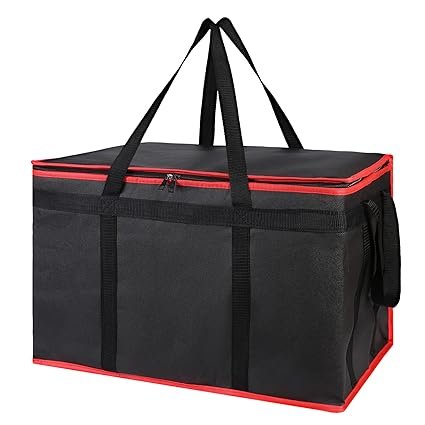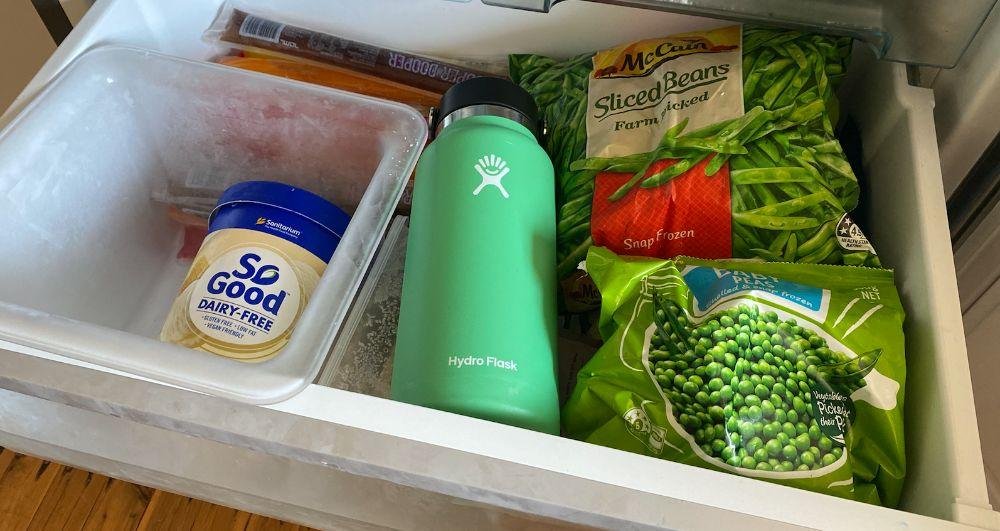There is no stress in traveling with frozen food if you do it right. With proper techniques and equipment, you can keep your food fresh and ready to eat on either a road trip or flying half around the world.
By choosing the best bags and coolers and adhering to some simple packing tips, you will learn how to travel best with frozen food.
This guide explains the practical and best way to travel with frozen food, whether in a car, a plane, or traveling to another country. All these will ensure your foods stay perfectly frozen from the beginning to the end.
What is the best way to travel with frozen food?
Following are the steps to keep food frozen while traveling:
1. Use the Right Equipment
Insulated Coolers
- High-Quality Coolers: When traveling for sufficiently long periods, invest in some of the coolers meant to retain coldness over an extended period. For example, YETI, Pelican, or Coleman Xtreme. These will have thick walls and airtight seals to keep the cold air in.
- Size Matters: Choose according to your requirements. A filled cooler will hold on to the cold more than a half-filled one.

Thermal Bags
- Easily Portable and Lightweight: Thermal bags are lightweight and easy to carry. It is ideal for short trips. Ideal for getting small errands done and even picnics.
- Layer It with Ice Packs: For more cooling add ice packs along with using these bags.

Ice Packs and Dry Ice
- Ice Packs: It is available in gel form. These ice packs are reusable and non-toxic. Simply freeze them overnight, and they will be ready to go by the time you leave in the morning.
- Dry Ice: Dry ice maintains an extremely low temperature, therefore, It is ideal for long trips. Always handle dry ice with gloves, and make sure you let your cooler get some ventilation to prevent the buildup of gas. Also, remember that not all flights accept dry ice. Check the rules regarding flight.

2. Pre-Freeze Items
Solid Freezing
- Deep Freeze: Before packing, ensure the food is solidly frozen by keeping it in the coldest part of your freezer for a minimum of 24 hours.
- Separate Portions: The freezing process should produce portions no larger than what can be kept from freely thawing in the cooler.
Airtight Containers
- Protect from Freezer Burn: Airtight containers or heavy-duty freezer bags will prevent freezer burn and block moisture loss from the food.
- Label and Date: Label each item and date it. This is important for identification and organizing.
3. Packing Hints
Pack Tightly
- Reduce Air Pockets: Minimizing air gap. It generally causes thawing, which can be achieved by packing items together as tightly as possible. One can even use filler items like crumpled paper or towels to fill in spaces.
- Layering Strategy: Put a layer of ice packs at the bottom, then your frozen items, and then top with more ice packs.
Wrap in insulation.
- Extra insulation: Fill up the cooler with some extra thermal blankets, some towels, or even newspapers, and top up with ice to give your cooler some added insulation value and help it keep cool.
- Cooler Insulation: Make sure that your cooler is properly insulated so that cold air being replaced with hot air is reduced.
4. Management during Transporting
Shading and Ventilation
- Keeping Cooler: Keep your cooler in some corner of your vehicle that is not exposed to direct sunlight and other hotspots like the engine area and the vehicle’s exhaust.
- Airflow Consideration: Open the window a little when the day becomes hot. The flow of the wind will help bring down the car’s interior to cool.
Minimize Opening
- Minimize Access: Pack smart so that you don’t have to access the cooler so many times. If there are similar things you are likely to need along the way, put them together to minimize the time spent in the cooler looking for packages.
- Use of Separate Containers: For items that you will need to use several times, separate the packs from the rest of the other packages to avoid opening the main cooler on so many occasions.
5. Air Travel Considerations
Consult with Airlines
- Regulations and Restrictions: Different airlines have different Rules for frozen food, ice packs, and dry ice. Check the airline always before you pack.
- Secure Packing: Wrap items in thermal blankets and label them clearly as “Perishable” when checking them in.

Security Packing
- Gel Packs: These are usually allowed through airport security.
- Separate Bin: During security checks, place frozen items separated and in a different bin for quick and hassle-free inspection.
Read Also:
- Essential 10-Day Travel Packing List for Stress-Free Trips
- Pet Travel to Europe from the USA: A Complete Guide
6. Layovers and Delays
More Insulation
- What to do: If you expect to have a layover or flight delay, more insulation or extra ice packs may facilitate your food remaining frozen.
- Staying Cool: Use airport facilities to re-freeze ice packs or replenish dry ice if you have unusually long layovers.
Traveling by Airplane
Traveling by air with frozen food involves more preparation than land travel. Here’s how to travel with frozen food by airplane:
- Airline Policies: Always check with your air carrier regarding their policy on carrying frozen food. Some airlines do allow ice packs, but others may have restrictions.
- Packing for Checked Baggage: Using checked baggage for your frozen food items is the best way to travel with frozen food. Wrapped frozen food in thermal blankets or put in insulated bags. Don’t forget to identify your baggage clearly as containing perishable (Spoil or decay quickly) items.
- International Travel: The procedure for packing frozen food in checked baggage varies internationally. Gel packs may be used, as generally they are allowed, but dry ice is not allowed.
- Security Checks: Do not forget the security checks. You must place your frozen food in a separate bin to avoid any complexity that can result from conducting checks.

General Tips on How to Travel with Frozen Food
- Monitor Temperature: Carry a little thermometer from home and check the temperature remains below 0°C.
- Stopping Regularly: If the road trip entails a lot of driving and frequent stops, it is important to be sure the cooler is out of the sun at all times and opening reduced to practical keeping it cool.
- Online Communities: Look in online forums or communities, eg Reddit, for personal tips and tricks. Just a quick search through “the best way to travel with frozen food Reddit” can give you insight from people who have overcome such issues.
- Adjust for Layovers: If you’re traveling by plane, take into account the total time your food will be out of the freezer. If there will be layovers, prepare extra insulation or additional means of cooling.
Frequently Asked Questions
What’s the Best Way to Keep Food Frozen While Traveling?
To Keep food frozen while traveling, Use a high-quality insulated cooler equipped with ice packs or dry ice.
Pre-freeze all items before packing and minimize opening the cooler. Pack things tight, but not overly so, and add other insulation as needed, like thermal blankets.
How Do You Transport Frozen Food Without Thawing?
Transportation of frozen food without thawing entails using a well-insulated cooler. Fill it with ice packs or dry ice. Wrap items in thermal blankets.
Be sure the cooler is tightly packed to minimize the number of air pockets. Keep the cooler in the shade if it’s possible, and try to minimize the opening time as much as possible.
Can I Travel with Frozen Food?
Yes, the frozen food can be carried in insulated bags or coolers with ice packages. These are meant to be carried in gel packs, which are often allowed through security at an airport.
One should, however, check with the policy of his or her airline if carrying the frozen food before embarking on the journey.
How to Transport Frozen Food When Moving?
Transport the frozen foods in a huge ice cooler which is filled with dry ice or several ice packs. Insulate with thermal blankets, and then tight pack the items.
When and if possible, transport the cooler in the air-conditioned car to keep the cooler as cool as it can be.
How Long Can Frozen Food Sit in the Car?
Frozen food will last in the back of the car for at least 4 hours if the cooler is appropriately insulated and has some form of ice pack.
The duration would further depend on the state of the different temperatures and the quality of the insulation.
How long can food stay frozen in a cooler bag?
If the cooler bag is packed tightly with either ice packs or dry ice, then the food can remain frozen for 24 to 48 hours.
The duration, of course, depends on how good the cooler is and what the temperature conditions are outside your car.
How Long Will Frozen Food Stay Safe?
Frozen food is said to be safe for an indefinite period as long as the temperature is zero degrees Fahrenheit or less.
However, its quality tends to decrease if it is stored for all that long. For better quality, frozen items may be put into service after a few months.
How to Keep Ice Cream Frozen for 3 Hours?
Keep the ice cream frozen for 3 hours with a technologically-packed, heavy-duty cooler plus dry ice or a lot of ice packs.
Open the lid to a cooler less often, so that a low temperature is assumed to be within the cooler.
How Do You Keep Frozen Food Frozen Without Electricity?
If you have no electricity, try to keep frozen food frozen with a fast and reliable cooler using either dry ice or ice packs. Wrap the items in thermal blankets. Keep the cooler in a shaded, cool spot.
How Long Can You Keep Frozen Food Out of the Freezer?
Frozen food can be stored out of the freezer for 2 to 4 hours; it can even last longer if it is inside a cooler or insulated bag that contains ice packs. Once it passes this time limit, it starts to thaw.
What Is the Safest Way to Store Frozen Food?
The safest way to store frozen food is in a freezer set at 0°F (-18°C) or below. Ensure the food is sealed tightly in airtight containers or freezer bags so as not to incur freezer burn.
Conclusion
In conclusion, the best way to travel with frozen food needs the right planning as well as appropriate equipment. You can keep such food frozen using insulated bags, quality coolers, and enough ice packs for a long period.
Keep in mind airline policy for air travel and if necessary, add dry ice or gel packs. As such, these tips and techniques will be very useful to enjoy fresh frozen meals regardless of where you are. Proper preparation will help you enjoy a smooth, trouble-free, and healthy journey.




